 Marketing Intelligence
Marketing Intelligence
How to Increase Organic Traffic to Your Website: A Step-by-Step Guide

Organic search makes up about 14% of all traffic across industries over the past 3 months.
That’s no small number. To give you some context, direct traffic is the champion at 76%, and the next highest is email marketing standing at 6%.
And the biggest bonus of organic traffic? It’s free. Take a second to consider what that means for its ROI and your business’s bottom line – over the long haul.

It’s a well known fact that the #1 result in Google’s organic search results has an average CTR of 31.7% and the #1 organic result is 10x more likely to receive a click compared to a page in #10 spot.
Winning the top spots for the right keywords guarantees you more traffic and revenue. It also helps you beat your competitors.
Dive in to find out how you can increase your organic traffic and boost your digital marketing results in just seven simple steps.
Increase your organic traffic in 7 steps
Step 1: Benchmark against your competitors
Step 2: Hunt down organic pages that just don’t perform
Step 3: Find better keywords
Step 4: Optimize top pages
Step 5: Rewrite meta tags to improve click-through-rate
Step 6. Create new blogs and refresh existing blogs
Step 7: Optimize content for featured snippets
Step 1: Benchmark against your competitors
Building a plan to increase organic traffic starts with zooming out and analyzing the big picture.
So, the first thing you should do is benchmark your performance against your competitors and industry to get your strategy on the right track.
I have a quick example to walk you through how it’s done.
Peer under your marketing channels hood
Similarweb Marketing Channel Overview feature gives you an inside peek at your competitors’ organic search performance. Ask yourself:
- Who’s winning in my industry?
- What are the organic traffic trends?
- Are there any noticeable patterns?
In the example below, does anything jump out at you?
Note: Both brands start with a slight decline, then show relatively steady traffic and finally have a steep decline from October – November 2021.

This insight allows you to see how your organic website traffic compares. If you saw declines around those same times then you’re still par for the course.
However, this doesn’t really tell us enough. After all, what is traffic worth if it’s not the right traffic?
If you look into Bounce Rate, you can get a better idea about the kind of traffic your competitors win. Drilling down into the engagement metrics, such as bounce rate, reveals if the traffic won is high-quality or not.
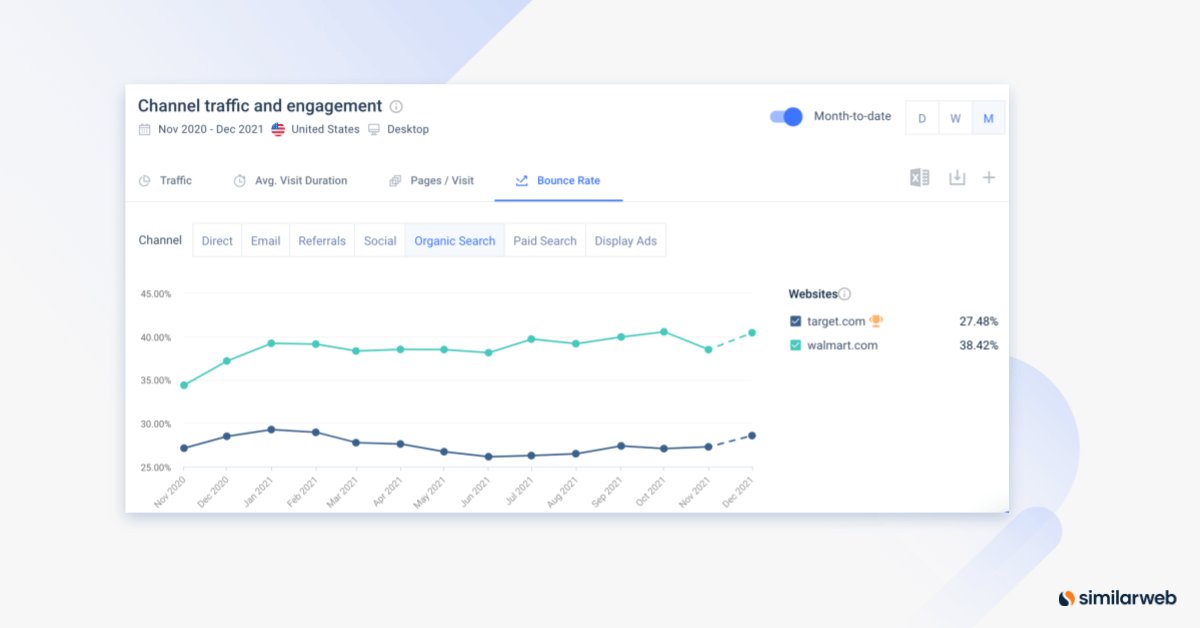
Let’s go back to the example for a second.
Walmart.com bounce rate is around 38% whereas target.com’s rate is approximately 27%. That means target.com’s organic traffic is higher quality and they’re likely doing a better job matching their content to the query’s search intent.
In this case, Walmart.com is winning a higher quantity of organic traffic, but target.com’s traffic is higher quality. On the bottom line though, walmart.com may still be getting more quality traffic because the site is reaching more people overall.
Understand your rank
Organic search traffic is a result of ranking high for specific keywords. Use the Ranking Distribution tool to quickly understand how you and your competitors’ websites rank on Google.
In this example, the ranking distribution confirms what we already thought. Walmart.com wins more of the top ranks than target.com.
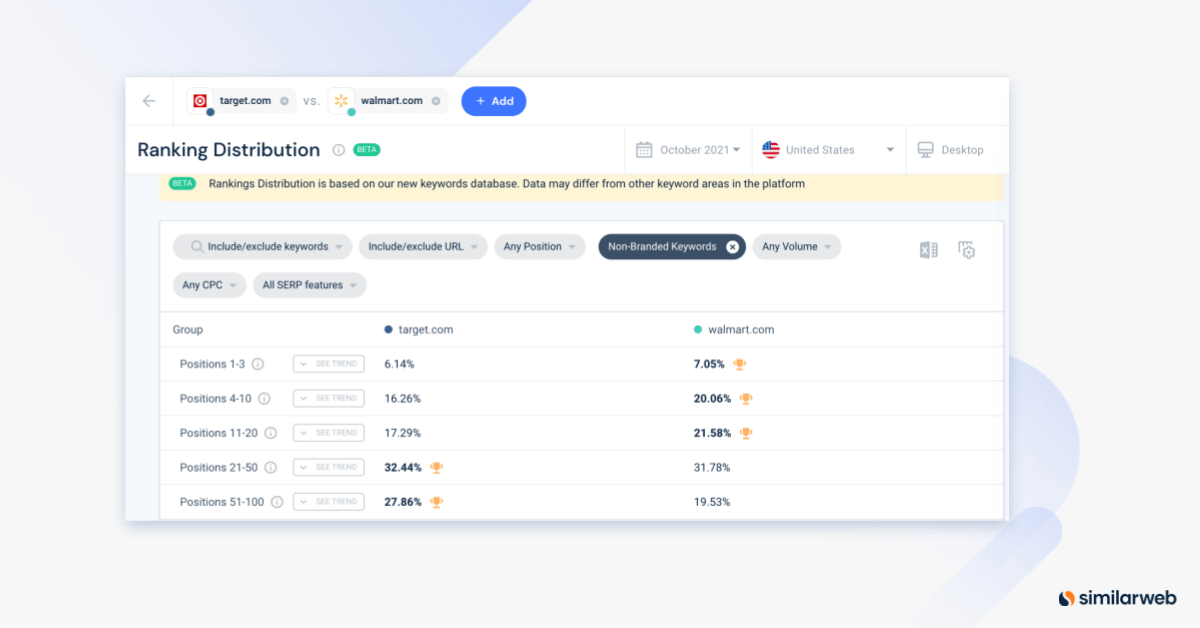
Are you also wondering how?
This is where keyword research steps in. Looks like walmart.com is targeting the term “ps5” very successfully. This is an opportunity for target.com to increase organic traffic to its website by adding this as a strategic keyword.
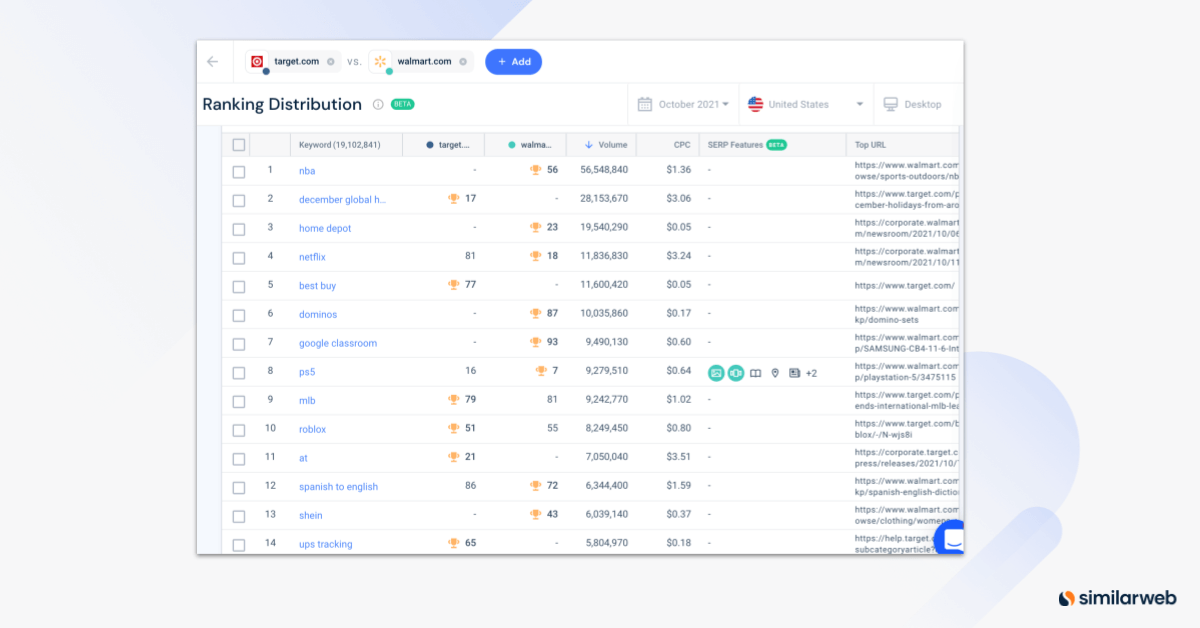
Pro tip: Evaluate just one website to see the changes month-over-month in ranking and to understand if its ranking is improving or declining.
Replace our example with the websites you are interested in and you’ve benchmarked your traffic and ranking to see how you stack up against the competition.
Step 2: Hunt down organic pages that just don’t perform
The only reason to create content on your website is to meet your marketing objectives. If a page doesn’t do that, it could actually be doing more harm than good.
I know it’s tempting to have content for content’s sake because it seems like more is better. But, you’ll want to remove low-quality, low-performing pages.
Website pages that either don’t drive organic traffic, have high conversion rates or land a lot of referral traffic eat up your crawl budget.
Let’s back up. A crawl budget is how search engines navigate a website – it determines how many pages you have, and which pages to “crawl” through.
The more time search engines spend crawling ineffective content on your website, the less likely they are to reach your best pages. Your goal is to make the most of your crawl budget.
Find and remove low-performing pages that are eating up your crawl budget to help search engines find your most effective content.
Helping search engines focus on your most important web pages can improve your SERP ranking and increase your organic traffic over time.
Step 3: Find high-value keywords
Would you buy a house with a weak foundation? Probably not.
Your keywords are the foundation of your SEO strategy. It’s critical that you find the strongest keywords for your brand to lay the groundwork for success.
As the saying goes, “The house don’t fall if the bones are good” (*queue Marren Morris*).
Here’s how Similarweb gives you the materials you need to build yours properly.
Let’s start with identifying the quick-win keywords.
Keyword Gap
This digital marketing tool reveals which keywords your competitors win traffic with that you aren’t targeting. Simply, enter your URL on the platform, click the “organic” tab, and filter by non-branded opportunities to get a list of keywords that you can add to your strategy and use to drive more traffic.
Below we get an inside look at walmart.com’s strategy and see keywords it wins traffic on that Target isn’t targeting. This information should inform Target’s team on how to adjust their plan to increase organic traffic.
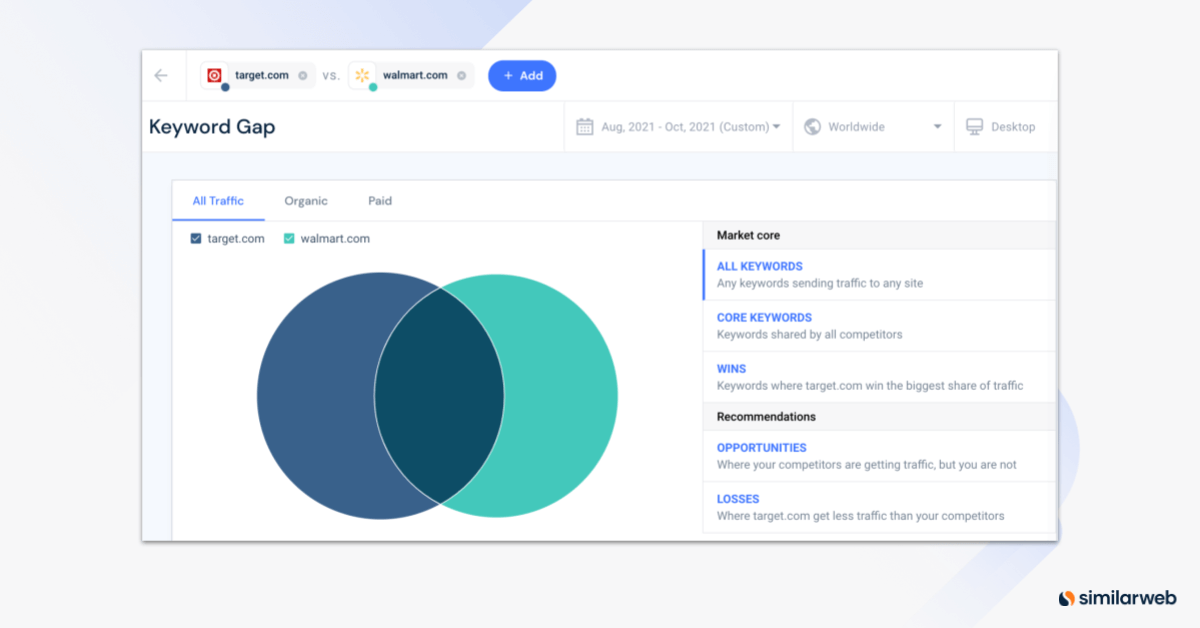
Keywords by Industry
This tool helps you understand which keywords are the most popular or trending in your industry. These keywords are usually influenced by news events, time of year, holidays, and other ‘real-life’ changes such as new product releases from brands in your industry.
Continuing with our eCommerce example, have a look at the insights below. If your website was competing in this space what would you note?
Hint: Gaming-related keywords appear to be performing very well for multiple websites including Amazon.

Pro tip: Also, filter by question queries to see the most common question-based searches in your industry so you can create relevant content that answers them and matches the user search intent.
Keyword Seasonality
Target keywords that aren’t even on your competitor’s radar yet. This tool reveals upcoming keyword opportunities based on past traffic patterns so you can predict what trends will emerge based on the time of year and target the relevant keywords in advance. Your competitors won’t know what they’re up against.
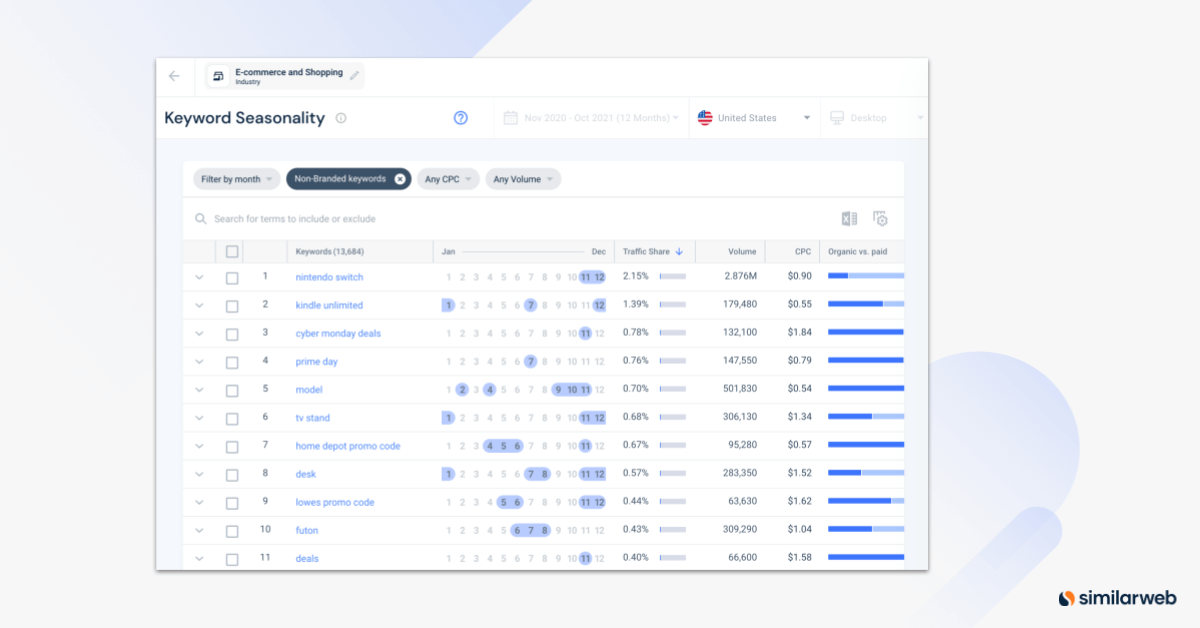
Keywords: Competitive analysis
The time has come to hone in on SERP features and long-tail keywords relevant to your brand. Long-tail keywords often drive less traffic in terms of volume than short-tail keywords. They are more specific so they tend to have more targeted search intent.
Think about it like the terms “ps5” vs. “ps5 black pricing.” Which term do you think is searched more frequently and which do you think is likely to lead to a purchase?
Let’s see if we can figure it out with SEO Competitive Analysis in Similarweb. Start by clicking on Search, and then Keywords.
Check out relevant SERP features first. When Google features your content in a SERP feature, you earn valuable real estate on the first page of search results. Use the keywords tool to find the top keywords driving traffic to you vs. your competitors, then find SERP feature opportunities.
For example, walmart.com is featured in the Images and PLA SERP features for the keyword “ps5.”
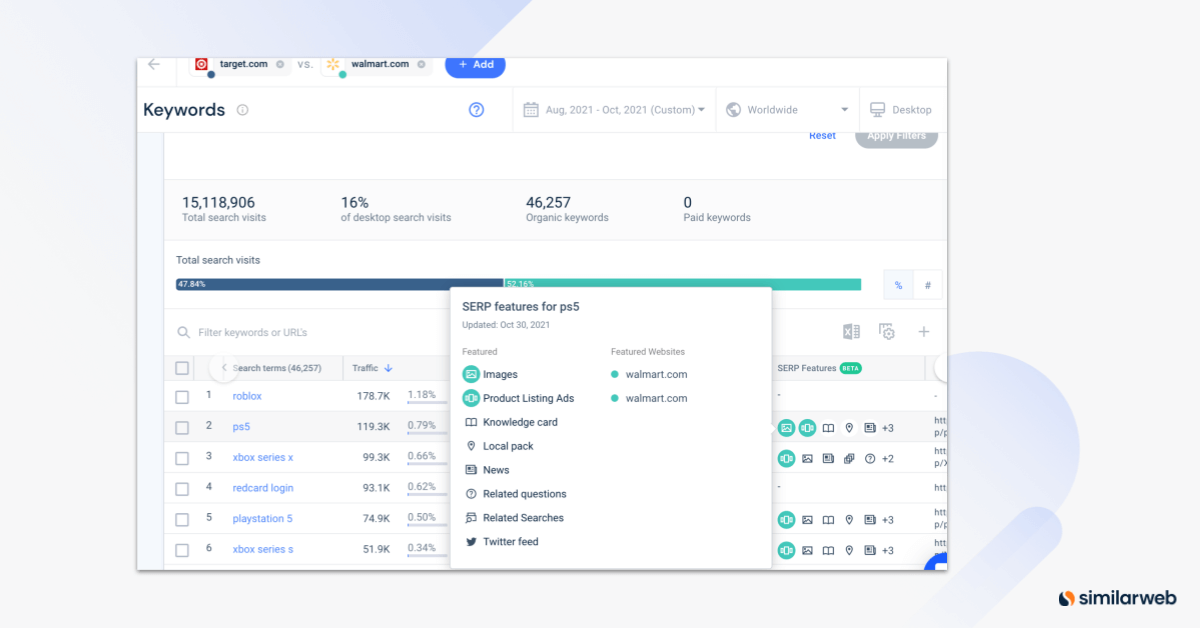
Helping to explain why walmart.com is dominating the traffic share for the keyword:
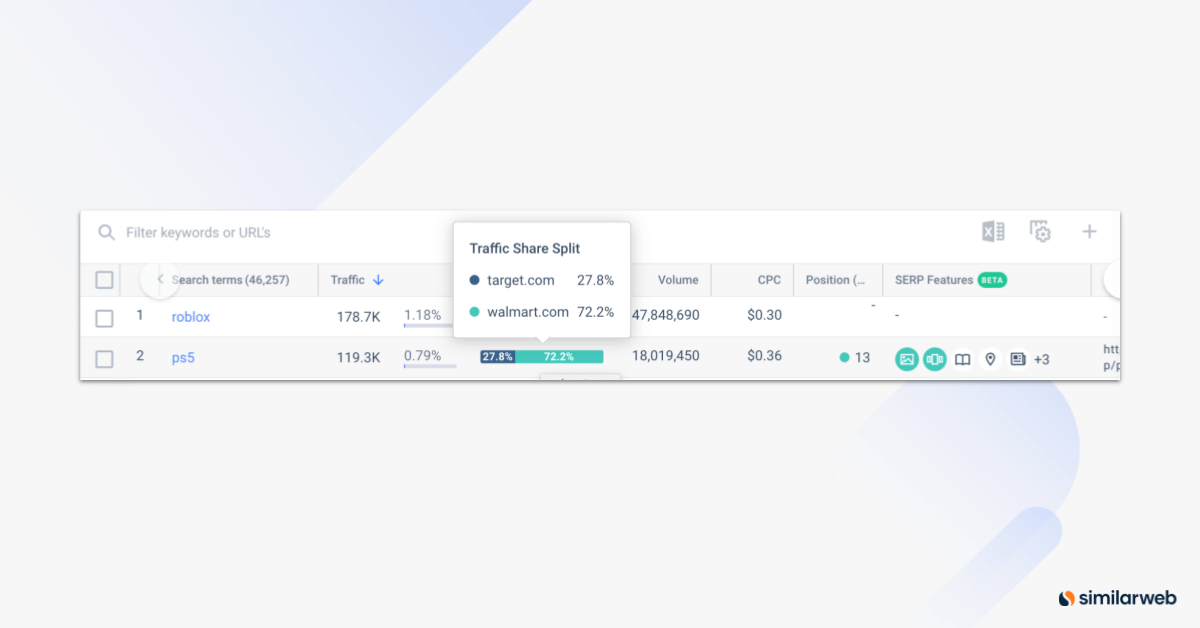
Wait, don’t leave this tab yet. You still have to click on Ranking Distribution. Then you can play with the filters relevant to your brand to discover long-tail keywords your competitors rank on.
For target.com, I filtered for the top 10, non-branded keywords with a volume of up to 20,000 and discovered relevant keywords including “pokemon toys” and “doormat.”
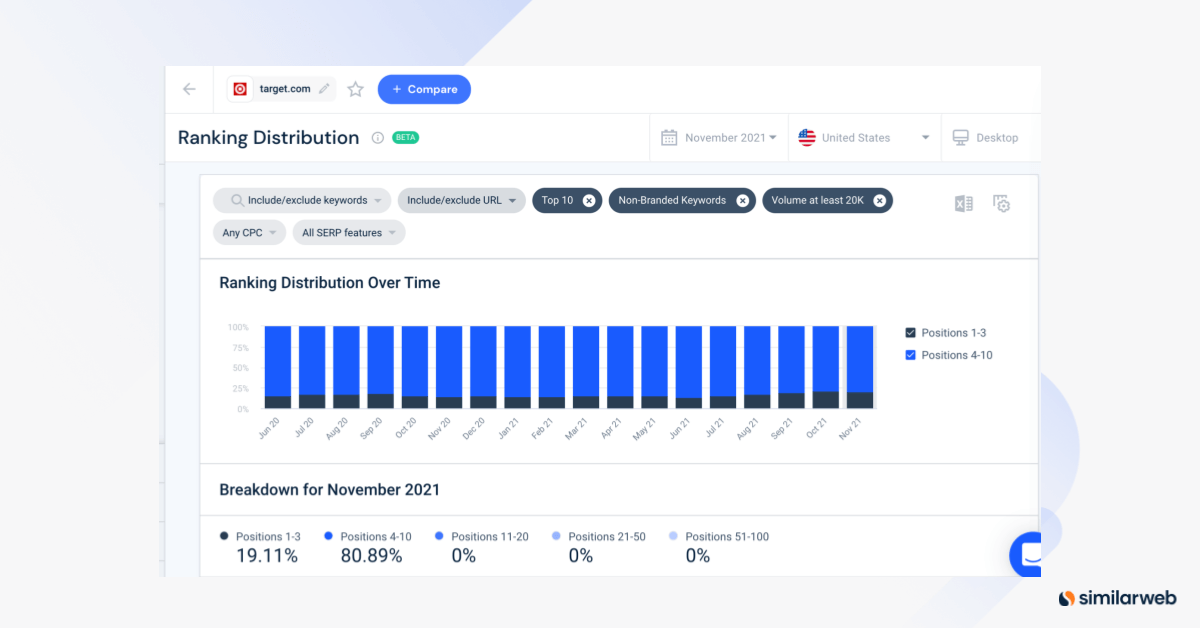
Keyword Generator
This tool will quickly help you increase your Click-through Rate (CTR). It reveals which search terms have high volume and low clicks, otherwise known as zero-click searches. This happens because the searcher can find the answer to their query directly on Google from featured snippets.
By investing in keywords that you know win clicks you’ll boost your CTR in no time. For example, with the “ps5” keywords notice how big of a difference there is in clicks for several relevant terms.
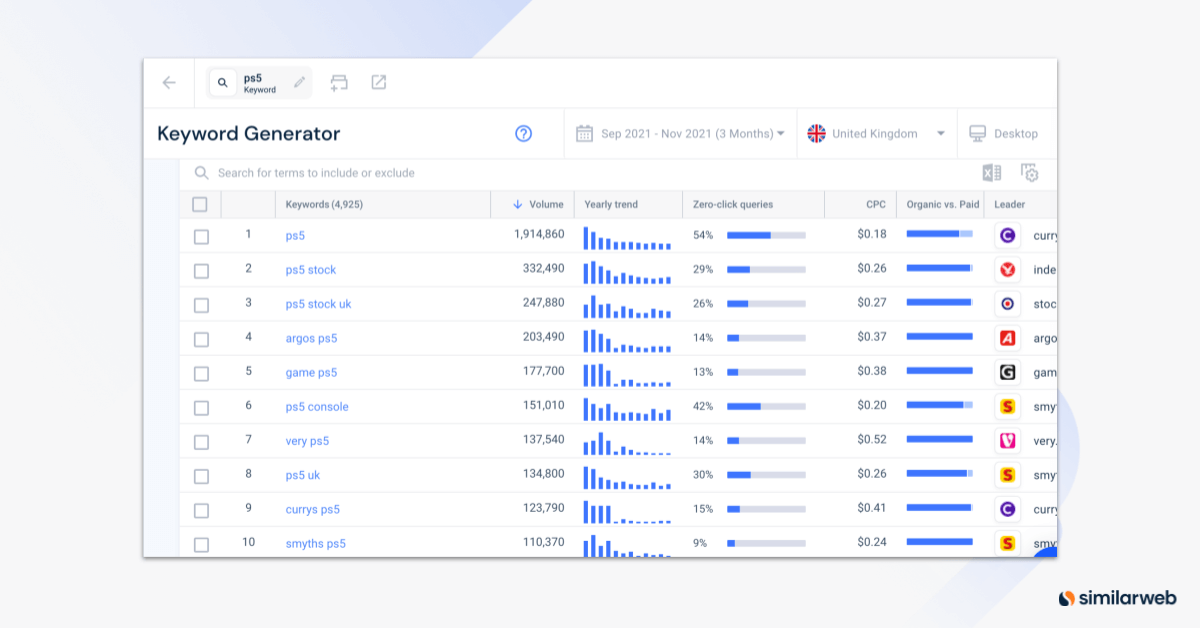
Step 4: Optimize top pages
Look into which of your top pages already have content that’s bringing in loads of traffic and content that’s ranking. You can expect to see overlap. Don’t neglect these pages or lose that traction. Keep each piece of content fresh and updated by:
- Refreshing relevant data
- Including new information on the topic
- Incorporating more links as you create more related content
- Focusing on outreach and quality backlinks
- Adding additional features like videos, case studies, Q&A, or examples
- Weaving in relevant key phrases and search terms in your content
Step 5: Rewrite meta tags to improve CTR
Once your content is ranking for your target keywords, your battle for traffic is halfway done. You still have to convince searchers to click.
Meta descriptions and HTML titles, otherwise called meta tags, are some of the most influential CTR factors. Conveniently enough, Google ranks pages with a high CTR better on SERPs, so by improving your tags you’ll win more traffic now, and improve your ranking in the future. Win-win.
To do so, ensure your HTML titles and meta descriptions include your keywords, meet the character limitations, and are SEO friendly. Also, check that your meta descriptions include a clear call to action and a hook that tells searchers the value.
You probably already guessed what I’m going to say next, but I’m saying it anyway because it’s that important. In all tags, you have to match user search intent. Double-check that you do and then check again.
Pro tip: To win more clicks, focus your copy on what’s in it for the reader. Ignore what you are “giving” and highlight what they are “getting.”
Step 6. Create new blogs and refresh existing blogs
Quality content matters big time. As every blogger knows, blogging eats up a lot of time but if you plan and optimize your content properly, it will pay off. It’s the cornerstone of your SEO strategy.
Organize your target keywords by use case, search intent, pain points, and persona in addition to search volume. Remember, you don’t blog for yourself, you do it for your target audience. Keep your content focused on the user experience and keep it reader-friendly.
When you consider how you will structure each blog:
-
- Answer the relevant questions fully
- Make your content skimmable
- Include visual content (for example: images, videos, and infographics)
- Make shareable, bite-sized content for social media
- Get relevant backlinks
Step 7: Update content for featured snippets
Google first introduced featured snippets and rich content in 2016, and they’ve grown increasingly more important over the years. Sometimes, this type of content answers the searcher’s query on the SERP itself, meaning the reader doesn’t have to click on any website to get the information they are looking for. Remember what these are called? Yep, zero-click search.
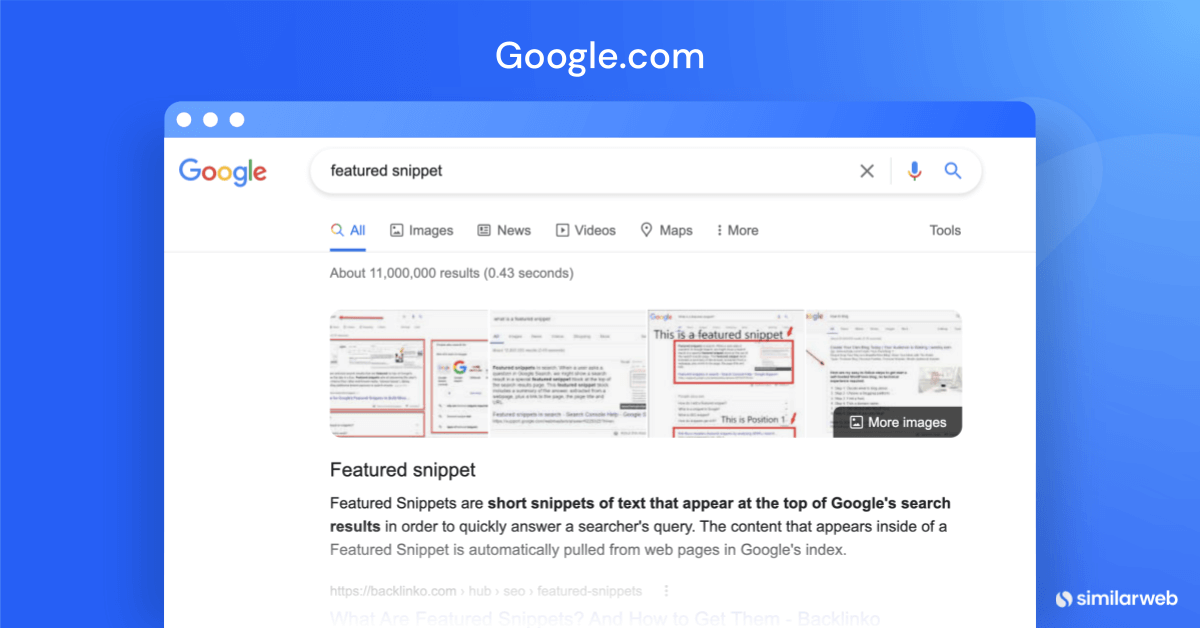
Creating content made for featured snippets means while users won’t necessarily click on your website at that moment, you will rank higher than the competition and increase your brand awareness.
Pro tip: Increase the likelihood that you win clicks from your featured snippets by creating content that answers the question in steps and has too many steps to show them all in the snippet itself. A cliffhanger is always a good trick to have up your sleeve.
To get the best chance of appearing as rich content:
- Use question keywords such as what, how and/or why…. And then answer that question as early in your blog as possible
- Create crawler-friendly content (throwback to step 1, I know)
Final thoughts
It’s clear why every digital marketing strategy aims to increase traffic organically. It’s not an easy goal, but it’s definitely a doable one. Increasing your website’s organic traffic takes time so stay true to your brand and your audience, apply the steps we went over and be patient.
Well, what are you waiting for? I’ve shared the best tricks with you so get started.
Wondering what Similarweb can do for your business?
Give it a try or talk to our insights team — don’t worry, it’s free!






